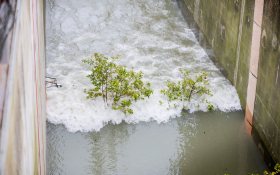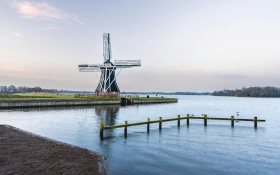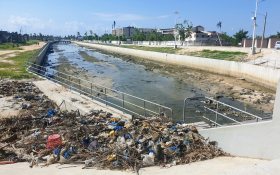Sheet piles enforced levee to show real strength at test site Eemdijk, the Netherlands
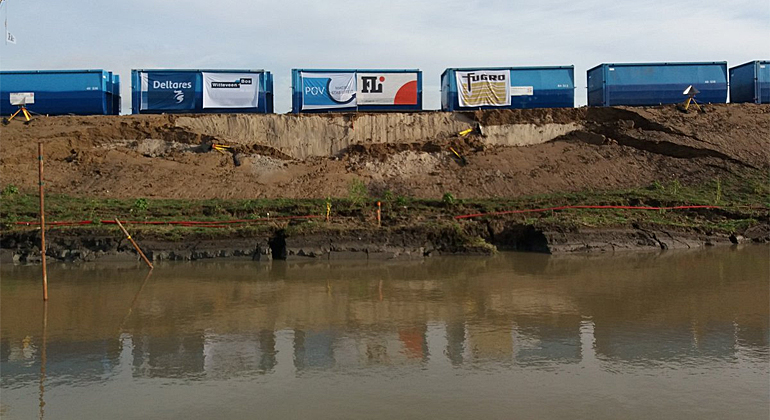
The levee at test location Eemdijk, the Netherlands, collapsed in the morning of 30 January. Step by step the ground water level inside the levee had been raised and it finally slided due to macro-instability.
The stability test was the first from a series of three. This first test levee was to provide reference data for the next final test with a sheet pile enforced levee that started this week.
The field test data will be used to improve design models for levees and are expected to make levee upgrade projects better and cheaper.
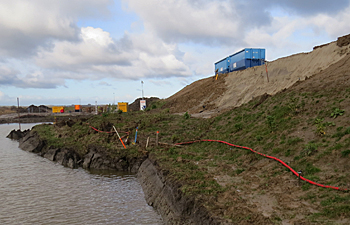 The first test levee was without sheet piles and its slide generated field test data that can be used as reference for the final test.
The first test levee was without sheet piles and its slide generated field test data that can be used as reference for the final test.
Cheaper strengthening of levees
The series of levee stability tests is part of the national Flood protection programme (HWBP) that includes research projects to develop new and less expensive levee strengthening techniques. New insights due to these stability tests are expected to show that the currently used piling is stronger than was assumed in the past.
This will allow to optimise the thickness of the sheet piling and the type used on individual projects and may allow less expensive sheet piles.
The test series is conducted by the HWBP programme in close cooperation with research institute Deltares, regional water authority Vallei en Veluwe, contractor Liebregts, steel sheet piles supplier Arcelor Mittal and consultants Witteveen+Bos and Fugro.
Large amount of data
On the test location two 60 metres long sand-clay levees have been constructed. One of which has now slided off as it was destabilized (see on top photo).
The test was closely monitored from both inside as well as from the outside of levee. So researchers were able to collect large amount of data on the real strength of the levee.
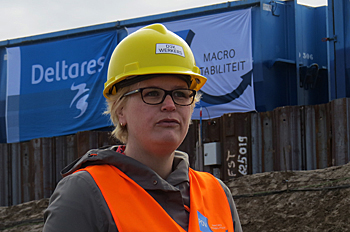 Coordinator Goaitske de Vries of regional water authority Hollands Noorderkwartier, confirms that the levee slided 'by the book'.
Coordinator Goaitske de Vries of regional water authority Hollands Noorderkwartier, confirms that the levee slided 'by the book'.
Carefully balanced design
‘We carefully balanced the design of the test levee’, explains coordinator Goaitske de Vries of regional water authority Hollands Noorderkwartier. ‘We wanted to build a realistic levee. Not too weak, so it could slide during its construction, but at the same time not so strong that we could not get it down.’
‘Eventually the first levee slided by the book’, says De Vries. ‘It took us six days to slowly increase the water level inside the levee, using a ground water infiltration system. At the toe we dug a ditch to weaken it even further. When the waterlevel inside the levee was 2.80 metres high we noticed movements inside the levee and we knew it was about to happen.’
Final test
A second test levee is now ready for the final test. It has been strengthened with sheet piles over the full lenght of 60 metres, and it will be destabilized by increasing the internal ground water level and by digging a ditch at its toe.
This final test will reveal the real strength of the enforcement with the steel sheet piles.
New flood risk standards
The national Flood Protection Programme (HWBP) includes some 300 projects to strengthen 1,100 km of levees (mainly river), 256 locks and several pumping stations.
The 7.4 billion euro programme must be completed by 2028.
Read the English factsheet Eemdijk test (download as pdf)
This news item is based on a publication on the website POV Macrostabiliteit (in Dutch only).
Read also on this website
● Super waves put old asphalt levee strips to the test at Deltares, 11 July 2017
● New Dutch 20 billion euros flood programme introduces risk-based standards for 2050, 17 September 2014
● Stress test made ancient clay-on-peat levee finally to fail, the Netherlands, 14 October 2015
More information
National flood protection programme (HWBP)
Utrecht, the Netherlands
+31 88 797 32 70
www.hoogwaterbeschermingsprogramma.nl
Time lapse and video on the collapse of the first test levee at Eemsdijk, the Netherlands on 30 January

